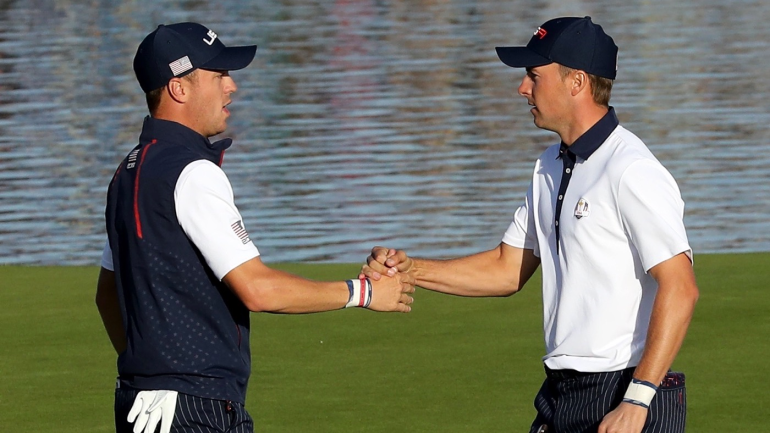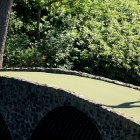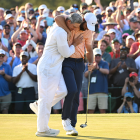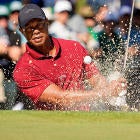
After how upside down the world (and golf world) has been over the last year and a half, it's fitting that the 2020 Ryder Cup will be played in … September 2021. It took an extra year of waiting (not to mention plenty of angst over who would actually make both teams), but one of the more anticipated Ryder Cups of the last few decades has finally arrived, and there is a lot to talk about.
The United States has infamously lost seven of the last nine Ryder Cups, and with the generational turnover in the team room (six rookies!) as well a course set up perfectly to their strengths on home soil where they probably should have won three straight, this feels like a very existential Ryder Cup. More on this below, but let's just say if the U.S. loses this one, the task force for the 2023 Ryder Cup in Rome might include multiple U.S. Senators.
However, it's Europe that has arguably the two biggest forces of nature in this event. Jon Rahm and Rory McIlroy almost certainly have to light up Whistling Straits given how well-built they are for a track like this one and how much Europe lacks length up and down their team. If one of their all-timers (Sergio Garcia, likely) or one of their newcomers (Viktor Hovland, possibly) gets hot, U.S. captain Steve Stricker might get in a canoe and start paddling his way out onto Lake Michigan before the avalanche hits.
The elephant in the room here is that if the heavily favored U.S. team starts to turn on one another on Friday or Saturday -- it doesn't seem like it would take a lot for this to happen right now! -- then Europe may not have to do much out of the ordinary to deliver loss No. 8 of the last 10. Still, the U.S. is the betting favorite for a reason (mostly that its team is much better on a course that will be set up perfectly) and should win going away. This has created a very precarious position for the U.S. in which winning is expected and losing is a borderline disaster. Scenarios like this are often more fascinating than two evenly-matched teams squaring off, especially at an event where it always feels close until the very end.
Let's get to 10 stories you can follow as the week begins at Whistling Straits.
1. Age vs. newbies: This is the story of this Ryder Cup. Europe is riding its most successful generation of Ryder Cuppers into the dirt without a true succession plan, and the U.S. has fully jumped to the next generation with eight of its 12 golfers currently in their 20s. Justin Ray's best Ryder Cup stat in the weeks leading in symbolizes this shift.
Career Ryder Cup points won:
— Justin Ray (@JustinRayGolf) September 17, 2021
Sergio Garcia - 25.5
Entire US team combined - 25.5
It seems as if a younger generation of U.S. players (Brooks Koepka, aside) has embraced this event in a way the Tiger Woods-Phil Mickelson generation never truly did. That, along with a wide talent gap, is going to be meaningful. Plus, America's more inexperienced stars have been far better than their vets over the last several Ryder Cups.
Europe was almost certainly always going to get hung up between generations both because the Lee Westwood-Ian Poulter-Sergio Garcia generation was good enough to get one last gasp and because they lack the Patrick Cantlays and Collin Morikawas of the world to hand things off to. I think that year is going to be this year at Whistling Straits.
2. What to do with the Big Golfer? Bryson DeChambeau, as always, appears to be the outlier. Based on his specific style (not to mention his sometimes-erratic disposition), I'm not sure you can play him in foursomes like they tried to do in 2018 with Phil Mickelson (to disastrous results). I bet they pair him with either Harris English or Scottie Scheffler in four-ball (Scheffler would be a great pairing) and then let him ride against Bernd Wiesberger or Tyrrell Hatton in singles. He's incredible when he's on, but after the summer he just had with the intensity ratcheted up for a week, he's also pretty difficult to trust.
3. How much can Rory and Rahm carry? Surely, Europe's path to 14 points goes through its two best players. They didn't get much from them in 2018 in Paris, but that was a different team and a much different golf course than this one. Those two, along with Viktor Hovland and Sergio Garcia, are the ones who can really stand up to Whistling Straits off the tee, and they'll both be asked to go the distance (Hovland might be as well). Rahm is scary enough right now -- as long as he he's healthy (he missed the cut at last week's Fortinet Championship after some illness) -- and McIlroy has historically been good enough at Ryder Cups to make any number of points between the two seem realistic. Europe might need them all.
4. What does Europe get from its lions? It's fun to think about Lee Westwood, Ian Poulter and Garcia as the conquering heroes they have so often been at this year's Ryder Cup. It's less fun to think about the fact that in the last three Ryder Cups (2014, 2016 and 2018), they have gone a combined 10-12-5 and struggled mightily in 2016 when Westwood went 0-3-0 by himself. Garcia is likely the linchpin here as I don't really think Poulter and Westwood are playable more than maybe a couple of times each (primarily because of how short they are off the tee). Garcia has been nasty from tee to green of late, though, and they'll need probably another Parisian performance (3-1-0) out of him to stand a chance against America's young stars.
5. Fan effect a year later: It was wise for the event to be postponed a year out because of the COVID-19 pandemic, and two stories have resulted because of that. The first is that fans of the European side will be a more limited than in previous years. The second is that this will feel like a celebration. The pandemic is not over, but things are certainly more optimistic than they were this time last year. Hopefully, this will engender a week in which the golf, the event and the sport are celebrated and not one in which the experience is more explicit than it should be (as was sometimes the case in 2016).
6. Course setup: The U.S. side has put its team together specifically to combat a 7,500 yard golf course, and they're likely going to set it up to accommodate their biggest weapon. That could mean a lack of rough or it could mean every pin is center-cut on the weekend, but it should mean that the home team wins its sixth event of the last seven Ryder Cups.
Here’s a sneak peek at the terrifying Whistling Straits rough this week: pic.twitter.com/FC6rh55BwV
— Dylan Dethier (@dylan_dethier) September 20, 2021
7. What's up with Collin Morikawa? One of the least-talked about narratives heading into this week has been Morikawa's health. He was downright bad during the FedEx Cup Playoffs, and whispers of a balky back began to bubble up. Over the last three months, he has statistically been the worst U.S. player, and he doesn't have a top-25 finish since the Tokyo Olympics. It looks like he's going to get a Dustin Johnson pairing, which should behoove him; however, if he falters in his first Ryder Cup, they could decide to hide him until the singles matches on Sunday.
8. Day 1 leader? Johnny Miller came on the Golf Channel's PGA Tour broadcast over the weekend and talked about the importance of leading after the first day. So I went back and looked at every Ryder Cup since 2002 to see just how important those first eight matches are. It turns out they're pretty important, though they're not the most important. That would be singles, which makes sense since there are 12 singles matches compared to eight on each of the first two days. Here's how the eventual winner of the Ryder Cup has fared on each individual day in the last nine events.
- Day 1: 7-2
- Day 2: 6-3
- Day 3: 8-1
It's important to lead on Friday night. It's far more important to win the singles matchups. The only time a team has won the singles matchups and lost the Ryder Cup came in 2010 when the U.S. won singles 7-5 at Celtic Manor but lost the Cup 14.5-13.5.
9. Which Euro emerges as a star? In each of the last three Ryder Cups, at least one European player who had never previously played in a Ryder Cup has netted at least 3 total points. In 2014, it was Jamie Donaldson. In 2016, it was Thomas Pieters. Then in 2018, it was both Francesco Molinari and Tommy Fleetwood. This year's options are Shane Lowry, Wiesberger and Hovland, and it's actually pretty easy to envision any of the three of them filling that role.
10. But really, how much fun is this going to be? It's the best event in golf, and we get an extra year of buildup for it (not that we needed it). Europe's last stand among this crop of players. A fresh start for the Americans. A week of the Brooks Koepka and Bryson circus. Rory and Rahm trying to drive a wedge in the side of a U.S. squad that will lean on its 20-something superstars. J.T. and Spieth trying to rally the troops in a post-Woods and Mickelson world. Sergio and Westwood hanging on for a final gasp at what could be their last Ryder Cup. A monster course tailor-made for the full-time hitters wearing red, white and blue.
Fall golf with temperatures in the 50s and 60s throughout with Lake Michigan framing what should be an existential Ryder Cup for the U.S. should it lose for a second time in its last three tries on home soil. It's the perfect capper to what has been an insane last 18 months in this sport. And we finally get some answers to all the theories, all the pontificating and all the questions that have been asked.
Three straight days of the best players on the planet playing the purest form of their sport, all of this after seven astounding major championships in the last 13 months and more drama than we ever could have imagined. It's almost surreal that it's finally here and that, after a year of waiting, we finally get a full week to enjoy the 43rd Ryder Cup.
2021 Ryder Cup gear now available
The Ryder Cup starts Sept. 24, and team-issued gear is now available. Get jackets, polos, hats, hoodies, and much more to support your team. Shop here.
We may receive a commission for purchases made through these links.





















